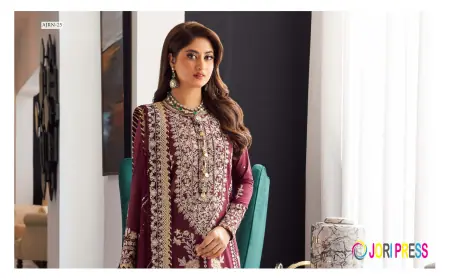The Maker’s Choice: Cotton Fabric for Functional and Fun Projects

If you love sewing, quilting, or DIY crafts, then you know how important it is to choose the right fabric. Cotton fabric is a go-to choice for countless projects, prized for its breathability, ease of handling, and rich variety of colors and prints. From quilting squares to tote bags and decorative pillows, cotton’s reliability makes it a favorite among hobbyists and professionals alike.
In this guide, we'll explore why cotton fabric works so well in craft projects and how to pick the best types for your needs.
Why Cotton Fabric Makes a Great Choice
Cotton’s popularity in crafting comes down to a few key factors. It’s soft, durable, machine-washable, and easy to sew. It doesn’t wrinkle or shift like slippery synthetic fabrics. Perfect for piecing quilts, cotton stays stable even after multiple washes. Plus, it takes dyes brilliantly, giving you vibrant prints or classic solids that can be mixed and matched.
For crafting, cotton behaves predictably when sewn. You can press seams, quilt layers, or create fine details without fuss. And its natural fiber content makes projects breathable and comfortable, especially when you are creating things like pillow covers or tote bags.
Quilting Essentials: Cotton Types That Work Best
When you’re quilting, not all cotton is created equal. The best options include:
· Quilting cotton: A medium weight cotton fabric that typically ranges from 40 to 180 gsm. It has a tight weave and high thread count, giving it color clarity and durability.
· Cotton lawn or voile: Lightweight and finely woven. These fabrics work great for overlays or dimension in quilt design.
· Cotton muslin: A plain, economical cotton that is often used as quilt backing or foundation blocks.
· Cotton flannel: Soft, cozy, and perfect for snuggly quilts or baby projects.
Each type of cotton fabric material plays a different role in quilting. Quilting cotton is strong and smooth for piecing. Muslin and flannel provide insulation and softness. Fine weight fabrics add vintage charm or delicate textures.
Craft Projects Beyond Quilts
Cotton fabric is useful far beyond traditional quilts. Here’s a look at popular craft uses:
· Tote bags and pouches: Sturdy quilting cotton is ideal for these and can handle weight and wear.
· Pillow covers: Cotton allows you to experiment with prints and easily change covers with the seasons.
· Fabric baskets and organizers: Use cotton canvas or twill blend for structure and stiffen shape with interfacing.
· Table placemats and runners: Cotton absorbs spills easily and cleans up well.
· Applique and patchwork art: Small cotton scraps can be turned into fabric panels or framed art.
Overall, cotton’s forgiving nature makes it ideal for beginners and advanced sewists alike.
Tips for Buying Cotton Fabric
When shopping either locally or online, keep these points in mind:
· Check the weight. For most quilting and craft projects, fabrics between 120–180 gsm work best.
· Consider pre-washed or pre-shrunk cotton to avoid surprises after washing.
· Look at thread count and weave tightness. Higher counts mean better print definition and smoother finish.
· Request fabric samples or swatches before buying yards, especially if matching across colorways.
· Choose cotton fabrics with certification like Oeko-Tex or GOTS if you seek eco-friendly or non-toxic materials.
Choosing Colors and Prints
One of cotton’s biggest strengths is print variety. You can find everything from vintage florals to modern geometrics and catchy novelty prints. Mix-and-match color palettes make designing easy and fun. Solid colors balance out loud patterns, and pastels soften bold prints.
Many quilters like to stick to cotton solids for foundation blocks and then feature patterned pieces for interest. Others embrace themed bundles, garden, travel, or holiday prints, for cohesive yet creative results.
Understanding Care and Maintenance
Most cotton fabric projects are machine-washable. Remember that cotton shrinks about 3 to 5 percent, so pre-washing or sizing up slightly is smart. Press quilts with a routine iron setting, cotton tolerates heat well but avoid steam if your backing is flannel or lightly dyed material.
Use a gentle detergent on bright prints to keep them from fading. And dry quilts flat or tumble dry on low to avoid distortion. Cotton handles wear well, which is why many heirloom quilts still look great decades later.
Working with Cotton Fabric Material: Techniques and Tools
Start by cutting with a rotary cutter and self-healing mat. Quilting rulers help maintain precision, especially when creating uniform blocks or strips. Use sharp sewing needles 70/10 or 80/12 for piecing fine fabrics.
Seam allowances should be consistent, typically ¼ inch for quilts. Use a coordinating or neutral cotton thread for stitching. And for craft sewing you may choose bâtik prints or small prints to reduce the appearance of seams.
You can also experiment with layering cotton and raw-edge applique or lace scraps for dimensional textile art. Cotton works well with embroidery too, think monograms or decorative stitches on pillow covers or tote bags.
Selling Cotton Projects: Tips for Boutiques
If you make handmade products for sale, highlight your cotton fabric choices in your branding. Buyers trust products labeled as “100% cotton” or “organic cotton” because of their comfort and quality.
Include care labels that instruct washing and pressing. Emphasize durability, easy care, and the handmade appeal of cotton pieces. Offer variety in prints or seasonal collections to keep customers coming back.
Final Thoughts
From quilts that keep memories alive to handmade bags and décor that you can wash and reuse, cotton fabric stands out as a truly versatile, reliable textile. Whether you are sewing in your craft room or running a small production studio, this material allows you to create beautiful, functional items that last.
Choosing quality cotton fabric material and understanding its characteristics means better results and happier customers. For anyone working with sewing or textile crafts, cotton is a smart, timeless foundation, and a fabric that just keeps giving.
What's Your Reaction?
 Like
0
Like
0
 Dislike
0
Dislike
0
 Love
0
Love
0
 Funny
0
Funny
0
 Angry
0
Angry
0
 Sad
0
Sad
0
 Wow
0
Wow
0



















































